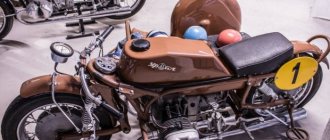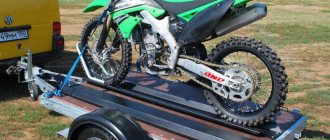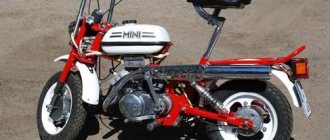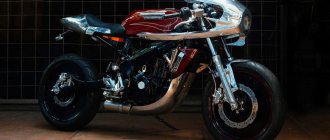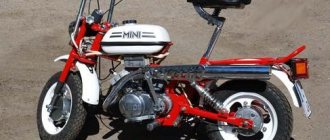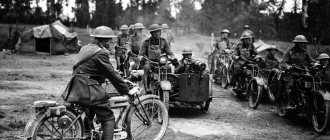Ever wondered why people so often do tuning of a Ural motorcycle with their own hands? In fact, the answer to this question is very simple. Do-it-yourself motorcycle tuning is several times cheaper than ordering work from a specialized workshop. And many people know the Ural motorcycle, so there are a lot of garage specialists around and many parts can be found on the secondary market.
Motorcycle Ural stock
The simplicity of the design of the Ural motorcycle allows you to install parts from Dnepr and other brands of motorcycles on it. And, if you tried to find information on the Internet, you could see that there is a lot of it there.
Belgian masterpiece
Two people worked on this model, one of whom was Belgian. One evening he walked into a local bar, in the parking lot of which there was an old Dnepr. That’s how he came up with the idea of restoring a Soviet bike.
The repair process and tuning took more than two months. Although it was initially planned to restore the motorcycle in the rat-custom style, in the end the old Dnepr combines several styles: scrambler, chopper and tracker.
For a more believable effect, the specialist used special paint to give the surface a rusty effect. The Belgian enthusiast added several parts from the famous Harley-Davidson to the Soviet bike: a custom steering wheel, a leather saddle and a brake light.
The master also equipped the engine with new Schaeffler bearings and pistons from the BMW R60, and the wheels were finished with shiny tires from Heidenau K37. Now the old “Dnepr” from 1970 has found a second wind and is ready to conquer new tracks.
Over the last ten or so years, the modern wave of customs has seen a huge influx in popularity, leading to an ever-increasing number of bespoke bikes. Whether it's a cafe racer, tracker or scrambler, no matter what style of custom motorcycle you want to build. Certain motorcycle models have many characteristics that allow them to be significantly more customizable than you might think. Below we'll break down what these qualities are, why they make the best projects, and even show you photographic examples of what custom bikes look like.
Classic donor motorcycles
Donor motorcycles provide the basis for a custom build, essentially serving as blank canvases that can be recreated in any way you like. Some designs are simple, making them easy to work with, especially older models that predate the advent of artificial reservoirs and modern electronic systems. The more primitive frame design makes it easier (if necessary to modify and then) install a new tank, plus older bikes are almost always easier to operate as they lack the computer controls found on today's scooters and the endless wires and unsightly array of gauges that go with him. Have become huge obstacles to overcome when working with a custom build.
In addition to being cheaper and simpler than modern ones, older motorcycles also have the advantage of much greater availability of parts. The workshops also produce a wide range of time (and headache) saving products for classic motorcycles, such as prefabricated subframes with hoops and conversion kits for installing modern Gixxers and CBR inverted forks on vintage models such as the Honda CB750 or BMW. Additionally, there is no shortage of information, tips and tricks regarding rebuilding old bikes on motorcycle forums and video sites. No matter what problem you're facing, chances are someone has already been there, figured it out, documented their process, and then shared it online with the rest of the motorcycle community.
Modern donor motorcycles
The emergence of a new wave is increasingly shaping many of the genres and trends emerging in the motorcycle manufacturing sector, with major manufacturers constantly copying the latest styles from the world of custom motorcycles. This phenomenon has also given rise to a number of modern production models that take inspiration from customs, such as the Ducati Scrambler series or the BMW R nineT.
These modular cars feature items such as headlights and subframes that can be quickly and easily removed by simply removing a few bolts and wiring harnesses, separated into separate units for the engine and chassis. What's more, manufacturers also produce huge collections of bolt-on parts and accessories for quick and easy customization (though admittedly, these parts usually come at a fairly high price). On top of that, quite a few shops make parts and bolt-on kits for these donor models.
In addition to the obvious benefits of cleaner emissions, increased fuel efficiency, improved reliability and significantly longer service intervals than their predecessors. Modern motorcycles, most importantly, provide noticeably better performance with today's chassis, suspension and braking systems, something that couldn't be said about the motorcycles of the 1970s.
Performance standards have evolved over the years, and what we might consider a mid-range bike almost certainly performs better than many sportbikes of yesteryear, with monoshocks, inverted forks, ABS disc brakes and twin frame spars (and other modern styles ) are increasingly becoming a standard set. There are also plenty of fantastic, high-performance naked bikes that come straight from the factory, most if not all of their wiring, gauges and other unsightly ancillaries neatly hidden from view.
General tips for assembling custom builds
Five Rules That Apply to All Custom Motorcycles
No matter what project style or donor model you choose, there are a few fundamental guiding principles that apply across the board. In fact, it is difficult to overestimate the importance of each of these five rules.
Test Drive the Donor: Even if the donor you buy doesn't work (consists of an engine and a few boxes of parts), it is still recommended that you familiarize yourself with the stock model's performance and driving characteristics before making a purchase. While the modifications you make may affect performance, the donor should still give you a good idea of what the ride will be like. You'll almost certainly never buy a car without getting behind the wheel, and motorcycles are no different.
Make a Plan: Besides sketching or photoshopping your design, you'll want to figure out what work will be required, what work you can do yourself. Or learn how to do it yourself through a friend or local garage and what you will need to outsource (and how much it will cost). If you are not familiar with motorcycle mechanics, wiring, welding, metal fabrication, and other aspects of the complete custom build process, there are plenty of blogs and Youtube videos.
Set a Budget: This may seem obvious, but to the uninitiated, it can be staggering how quickly the cost of a custom project can turn into a figure well beyond the original estimate. Thoroughly understanding the entire build process from start to finish will make calculating the total cost of a custom bike much easier.
Start Small: When you first hit the custom motorcycle bug, it can be easy to start planning complex builds, especially after spending hours poring over images of professional builds on custom motorcycle blogs. But the reality is, if you've never built, you're almost always better off starting small with a less ambitious, more manageable project. If you find that things are going well and your hobby still resonates with you, you can always move on to bigger and better builds.
Safe Start: Just because a particular model is customizable does not necessarily mean it will suit you personally. Custom or not, it's important to choose the right bike in terms of size and power based on your riding ability (or lack thereof).
User errors in motorcycle customs
Features to Avoid When Buying a Donor Bike
Whether you're dealing with a vintage model or one fresh off the showroom floor, there are a few common elements to avoid when looking for a donor bike for a project.
Fancy Frames: Fancy designs require an untold amount of extra work, not to mention creativity (and courage). There's a good reason why the classic double-cradle tubular designs on the CB750 and KZ650 are so often used for projects, as modifications and upgrades are easier, plus the more simplistic design fits better with a much wider range of styles than more unique chassis configurations.
Electronics and Wiring: We already touched on this above, but given its extreme importance, it's probably worth mentioning a second time. In short, the more wires and electronics there are, the more work you'll have to do, rerouting or otherwise hiding it all is much easier said than done.
Other "weird" components: While not as complex as a fancy frame, some components are difficult to work with or hide, such as the Telelever suspensions found on many BMW models. Odd and/or rare wheel and tire sizes can also cause problems, as you'll be pretty limited in terms of aftermarket options without some pretty complex custom work.
Model Rarity: This only really applies to older models, but using a rare donor can easily lead to problems down the road. Even if the bike in question is a cheap, rare one, it can be extremely difficult to find basic parts to keep it on the road.
Fairings and Body Panels: Choosing a donor bike that comes standard with fairings is not necessarily a bad idea. It's important to remember that often fairings and panels hide wiring and electronics, fluid reservoirs, radiators and other nondescript components. Unless you plan to keep (or change) some or all of the plastic parts, you'll need to have a very clear idea of what the bike looks like without them before considering it as the basis for your build.
Large selection of motorcycle accessories, equipment, spare parts here:
Buy accessories
BMW R80/R100
BMW air engines are increasingly becoming a platform for custom enthusiasts. Despite its limited rake angle, the Beemer's prominent cylinder heads give it a distinctive and easily recognizable appearance.
Backed by the reliability and engineering for which Germany is famous, the R80 and R100 can easily hit the 100,000 km mark on the odometer (with proper maintenance), are powerful enough for touring and freeway cruising, and can be in good shape for under $5,000.
BMW R nineT
The BMW R nineT, designed by Ola Stenegard, was the first model in the German brand's Heritage series, first released in 2014 and quickly becoming one of, if not the most highly customizable motorcycle in production.
Modular design of a retro boxer, 110 hp. has been carefully calculated to make modification easy, with a simplified (and separated) wiring harness and an easy-to-remove subframe that features mounting points that are ideal for a custom build. The cost of a used one is about 9,000 - 13,000 $.
Ducati 900SS
Although admittedly the bike has grown a bit since it left the factory decades ago. The 900SS still boasts all the hallmarks of Ducati, with its signature L-Twin engine housed in a trellis frame and combined with a performance-oriented chassis.
Remove the clunky, bulging fairing, cut off the subframe, and you're on your way to a cool Ducati café racer. Although, as El Solitario brilliantly demonstrates with the design shown in the photo; The 900SS can be transformed into all sorts of builds. The cost of a used one is about 3000 - 5500 $.
Ducati Monster
Interestingly, the Ducati Monster started out as something of a custom motorcycle, with Miguel Galluzzi tasked with designing the headlight, tank and tail, as well as the existing engines and frame.
Like the 900SS, the Monster features all of Ducati's modern signature elements, although it comes as standard as is. The Monster has been in production for over a quarter of a century, and is available in a wide range of models, years and engine sizes to suit the budget or riding skills of almost any aspiring builder. Price: from 3000 to 9000 $.
Ducati Scrambler
The Scrambler accounts for more than a quarter of all Ducati sales and is a retro-styled line designed to cater to customization needs. Like the BMW R9T, Ducati's Scrambler family has been designed to be tailored to individual needs, and as such the manufacturer offers a huge catalog of bolt-on goodies and accessories, as well as a host of turnkey options.
And, in addition to the regular version with an engine capacity of 803 cc. cm and a beginner-friendly model with an engine capacity of 399 cc. cc, Ducati now also produces a larger 1079 cc variant. see Price: 7000 - 9000 $.
Harley-Davidson Iron 883
One of the smallest models from Harley-Davidson, the Iron 883 is not only an affordable American V-Twin donor bike, but its decidedly spartan and minimalist nature makes it an ideal candidate to climb up the bench. The popularity and abundance of the 883 also means that for a 49 hp cruiser. there is a huge aftermarket market. Price: 6000 - 7500 $.
Honda CB750
The Honda CB750, which first hit the roads in 1969, has been a game changer since its launch. And today it is by far the most popular platform for motorcycle customization. Almost everything about this car is customizable, and its inline-four engine still delivers strong performance even by today's standards. It has a variety of parts and accessories that are unmatched by any existing model. If we had to narrow this list down to one model, it would be the CB750. Price: 3000 - 6000 $.
Honda NX650 Dominator
Dominator (or "NX650") with 45 hp out and a dry weight of less than 165kg (even less when stripped of the unsightly '90s-era fairings). Definitely makes it one of the best donor bikes for street tracker and street scrambler builds. Despite the spoke wheels, nearly nine inches of suspension travel and roughly 10 inches of ground clearance (plus the factory skid plate), the Japanese Dominator is also incredibly competent in muddy conditions. Price: 1500 - 2500 $.
Kawasaki W-650
The Kawasaki W-650 is essentially a modern Japanese clone of the classic British parallel twin (a la the Triumph Bonneville). As such, it boasts an unmistakably retro look - taken from British bikes of the 1960s, as well as the W Series' own range from the same era - while offering modern reliability. These factors make the W650 ideal for McQueen-style customs, resto mods, and racers of the era. Price: 3500 - 5000 $.
Calculate and compare MTPL for a motorcycle:
Go to website
Moto Guzzi V7 III
Another European machine with a distinct and instantly recognizable powertrain, the Moto Guzzi V7 III is a modern retro model available in a variety of styles and backed by a longitudinally mounted V-twin.
While the V7 isn't exactly a performance machine, it still has more than enough power for thrills on the road, and as a donor, the bike is full of character. Late model, low mileage examples can also be purchased at reasonable prices. Price: 4500 - 6000 $.
Moto Guzzi Le Mans
First put into production in the mid-1970s, Moto Guzzi's Le Mans began as a prototype race car based on the Italian firm's original V7 from the beginning of that decade. Like its modern V7 III counterpart, the Le Mans, which takes its name from the iconic French endurance race, offers a more authentic vintage look from the donor, retaining the previous model's transverse 90° V-twin and instinctive character and appearance. Price: 4500 - 7000 $.
Suzuki GSX-R750
Like the CB750 before it, the Suzuki GSX-R750 was a game changer when it debuted in the mid-1980s. And the racing replica completely changed the definition of the modern class of sportbikes. And while early models command high prices, examples from the 1990s and early 2000s boast powerful inline-four engines and modern aluminum twin-spar frames and chassis.
Admittedly, the Gixxer 750 and 1100 donors don't lend themselves to a wide variety of build types, although if you want a vintage sportbike resto-mod, an endurance racer's build, a retro street fighter or a superbike-based cafe racer, the GSX-R is a great choice. fantastic choice. Price: 2000 - 3500 $.
Triumph Bonneville
Introduced in 1959 and still in production today, the Triumph Bonneville is considered by many to be the top donor for café racer and scrambler builds. as the iconic British bike played a key role in the rise of both genres.
The famous Bonnie engine and tank are ideal for a custom build, as is the durability and popularity of the model and a huge selection of spare parts. With 46 different production models to choose from, this machine can be supplied with both modern and vintage donor platforms. Price: 3000 - 7000 $.
Yamaha SR400 and SR500
Yamaha's SR400 and SR500 motorcycles were released in the late '70s and remain in production today, a little over four decades after their launch. The distinctly stripped-down nature of the half-duplex cradle chassis and the simplicity of the 399cc single-cylinder engine. and 499cc air-cooled, the SR provides the perfect blank canvas for lightweight builds. Price: 2000 - 4500 $.
Yamaha Virago
As a more affordable Japanese alternative to American-made cruisers, the Virago is becoming an increasingly popular customization platform, especially for early builders. And despite its age, the Virago, which was produced with a wide range of performance characteristics, is actually quite an advanced bike, built on a surprisingly sporty frame and one of the first to feature a mono shock absorber. The Virago is also offered with a wide range of plug-and-play conversion kits, custom exhaust pipes and subframes. Price: 1500 - 2500 $.
Yamaha XS650
The Yamaha XS650 is a mid-size vintage classic with plenty of power for freeway cruising, yet light enough to suit most build genres. The design is a vintage foundation with an attractive tank, side covers and exhaust pipes in stock form, and the wide availability of parts (and available knowledge on the forums) helps solve the gremlin problem and simplify the assembly process. Price: 2000 - 3500 $.
Yamaha XSR700 and XSR900
Modeled after the XS650 and penned by a custom motorcycle legend, the Shinja Kimura, Yamaha XSR700 and XSR900 are modern retro bikes based on the MT-07 and MT-09 platforms. As with Ducati's Scrambler and BMW R9T, the XSR models have been designed to be modular and allow for easy customization. The XSR also has more complete bolt-on kits than any other current production motorcycle. Price: 6000 - 7000 $.
Buy motorcycle tires with delivery throughout Russia:
Buy motorcycle tires
Source: hiconsumption.com
Share with friends
Brutal design
In this model, the author decided to give a brutal look to the old bike, using mainly Soviet-made parts. He decided to emphasize the metallic essence of the motorcycle. To do this, he used several alloys: iron, aluminum, chromium.
The engine, rear wheel and steering wheel remained from the Dnepr 11. The fork, tank and front wheel were taken from IZH. Tractor Belarus was happy to provide a headlight and fitting for the bike.
In addition, the master himself built a fiberglass saddle. The taillight and oil pressure gauge came from the Zil-164 motorcycle.
Every detail has been repaired, painted or adjusted. As a result, the bike came out so powerful that it could compete with Harley himself.
Spectacular bike
To create this masterpiece, a resident of Bashkortostan decided to attach a car wheel to a motorcycle. Parts from various vehicles were also used in the restoration.
The front brakes and fork came from the IZh Orion, the carburetor from the VAZ-2106, and the ignition from the Oka. After the repair, the motorcycle turned out to be impressive, its length was 2720 cm.
From the old Dnepr, only the gas tank and engine remained in the restored model. This motorcycle was restored back in 2007.
At that time, many social network users were delighted with the tuning. However, there were those who called the product impractical and inconvenient.
Heavy KMZ motorcycles have become famous for their strength and durability, which now remain their main advantages. These models do not allow enthusiasts to forget about the legendary technology and create unique cars on its basis.
Do-it-yourself Ural motorcycle tuning
If you own a Ural motorcycle, but its appearance does not suit you, and you constantly look at foreign handsome men, do not despair. You can improve your vehicle. Most often, they buy a domestic motorcycle just for the shell, and everything else is redone.
Tuning the Ural will take you a lot of time, but it is a very exciting process, and the result will exceed all your expectations.
Before you get started, check out all the proposed upgrades and photos of motorcycles on the Internet.
Having decided, you can begin work. First we redo the rear part of the frame.
- The pendulum needs to be expanded.
- Cut off the seat tubes.
- We weld curved pipes with a diameter of 28 mm, no less. This is not only a beautiful decor, it is also a headscarf amplifier.
- To make the suspension softer, the rear shock absorbers need to be installed at an angle.
- When you put the wide rear wheel in place, make sure that the rubber coupling works without distortion.
- The footrests need to be moved forward, it will be more comfortable for your legs.
- The frame needs to be lengthened by ten centimeters.
- The engine moves backwards.
Perhaps in this case the landing will be incorrect. But for every motorist it is different, individual.
After completing all the work, select a workpiece, perhaps from a stroller, for the rear wing. If you want it to be deeper, you can cut plates from it and butt weld it to the wing.
Let's start working on the tank:
- Use a grinder to remove the glove compartment.
- You also remove the neck and tunnel.
- A wedge is used to cut the top of the tank.
- The two halves are welded at the back. And the neck and tunnel are welded.
- To keep everything sealed, use epoxy resin.
Now we work with the seat:
- You need to cut the base from two-millimeter steel.
- Place thin foam rubber under it.
- The finished structure can be covered with either suede or leather.
The steering wheel needs to be made simple. Everything is cut from a single piece of metal. This is the handle, clutch lever, brakes. For the mirror stand, cut blanks from eight-mm steel. You can buy a housing for a mirror in a store or make it yourself in the form of a sphere.
Silencers are located on the right side.
- Weld the left exhaust pipe without bending it.
- The right pipe remains standard, but it needs to be shortened a little at the top so that the leg does not melt.
- The seams are cleaned, polished and chrome plated.
- To get a chopper sound, you can insert valve springs from a car into the mufflers.
Engines in the Urals can be boosted. When working properly, its power increases to forty-two horsepower.

